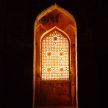Satpula, or seven bridges, is one of the few surviving remnants of the almost completely eradicated 14th century city built by the controversial sultan of Delhi, Muhammad Tughlaq. After moving his capital a few kilometers north from the previously established stronghold of Tughlaqabad, the sultan had an extensive network of walls built which linked up with the older settlements of Lal-Kot and Siri. These fortifications enclosed a wide area which was christened Jahanpanah, the “Refuge of the World,” which is sometimes counted as the fourth “city” of Delhi.
Lucy Peck, the author of Delhi: A Thousand Years of Building, describes Muhammad Tughlaq’s capital as “the most haunting and mysterious of the cities of Delhi in that there is very little left, even of walls and gateways, to give one any idea what it must have been like when it was built.” These days, most of Jahanpanah has disappeared, having either been destroyed long ago, or else recently buried under the high-rises of posh South Delhi neighborhoods. A person can easily walk or drive through this part of the city without noticing anything built before the 20th century. Some of the important structures which at one point existed within Jahanpanah’s walls, such as the impressive Begumpuri and Khirki mosques, or the unusual palace complex at Bijay Mandal, survive, but little of the walls themselves remain.
However, there is one point where the fortifications of Muhammad Tughlaq’s capitol were presumably made stronger than elsewhere, and so have managed to withstand the ravages of history and urban growth. This was at Satpula, where the battlements passed over a small stream (which has since been diverted off to the east). A dam was built here, behind which a lake developed. As the fortifications were naturally perforated at this location, the dam was designed with defense in mind. A moat was dug in front of the structure’s sluice gate, while a system that lowered wooden boards to block off the dam’s water tunnels was put in place both to keep water in and invaders out. The dam was provided with a fortified parapet along its causeway from which soldiers could repel any attackers bent on forcing their way through, along with two large bastions at either end which could serve as barracks. What might have been a natural weakness in Jahanpanah’s fortifications was thus converted into a strong point, and now, over half a millennium later, this is one of the few places where the battlements of Muhammad Tughlaq’s city survive.

A view north along the causeway of Satpula dam.
Satpula is an interesting site to visit because it’s such a unique addition to Delhi’s historical geography. It is simultaneously a foreboding piece of defensive architecture and a vital, lifegiving element of civic infrastructure. It came about during a deeply unsettled time in the history of North India (some of the challenges being due to the disastrous whims of Muhammad Tughlaq himself). This was an era when various Mongol and other central Asian groups regularly descended into north India, and so posed a continuous threat. The region was also heavily affected by the bubonic plague around this time, along with severe famines. Satpula was thus meant not only to keep the Mongols at bay, but also to trap water within the walls of Jahanpanah which could be used for agriculture even when the enemy was at the gates. A standing reservoir backed up behind the walls which existed for long enough that a large deposit of silt developed, leaving behind a wide flat area that survives to this day and is used by the locals as a cricket field.

View through one of Satpula’s water tunnels. The fellow to the right is standing on what was once the bottom of the reservoir formed by the dam.
My visit to Satpula was a bit of a mixed bag. The 14th century dam was open to the public, and there was no security guard. It was possible to climb over, under, around, and through the ruins without getting yelled at. On the other hand, the site’s a local hangout, and as a very obvious foreigner I attracted quite a bit of attention from curious foul-mouthed boisterous youths who constantly came over and wanted their pictures taken (all while making raunchy jokes at my expense in Hindi which they assumed I didn’t understand…comes with the territory). It wasn’t a super uncomfortable sort of attention, but it meant I had to move through the site much quicker than I would have liked and wound up not taking anywhere near as many pictures as usual. There were also several drug addicts hanging out in dark passages huffing whatever it is one huffs in Delhi these days. Much as I’d prefer to strongly recommend every place I cover in this blog, I wouldn’t advise visiting Satpula alone.
But none of these challenges mean that Satpula isn’t a fascinating, overlooked, piece of history. I can think of no other site in Delhi quite like it.
If you enjoyed this post, please consider supporting me on my Patreon page. There, you can download an extended edition of my book The Green Unknown which includes several chapters available exclusively on Patreon.

Classic Delhi rapscallions.
